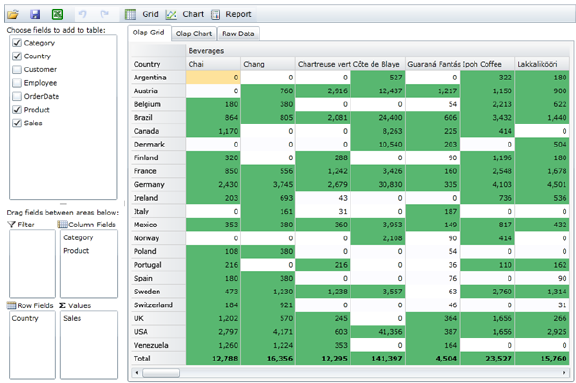
The C1OlapGrid control derives from the C1FlexGrid control, so you can use the grid’s custom cells features to apply styles to cells based on their contents. This sample shows a grid where values greater than 100 appear with a light green background.
The C1FlexGrid control has a CellFactory class that is responsible for creating every cell shown on the grid. To create custom cells, you have to create a class that implements the ICellFactory interface and assign this class to the grid's CellFactory property. Like custom columns, custom ICellFactory classes can be highly specialized and application-specific, or they can be general, reusable, configurable classes. In general, custom ICellFactory classes are a lot simpler than custom columns since they deal directly with cells.
Here is the code which implements a ConditionalCellFactory class responsible applying a custom green background to cells with values over 100.
public class ConditionalCellFactory : C1.Silverlight.FlexGrid.CellFactory
{
public override FrameworkElement CreateCell(C1FlexGrid grid, CellType cellType, CellRange range)
{
// let base class to most of the work
var cell = base.CreateCell(grid, cellType, range);
// apply green background if necessary
if (cellType == CellType.Cell)
{
var cellValue = grid[range.Row, range.Column];
if (cellValue is double && (double)cellValue > 100)
{
var border = cell as Border;
border.Background = _greenBrush;
}
}
// done
return cell;
}
static Brush _greenBrush = new SolidColorBrush(Color.FromArgb(0xff, 88, 183, 112));
}
And here is the code required to use this on our C1OlapGrid:
// apply conditional formatting to grid cells
_c1OlapPage.OlapGrid.CellFactory = new ConditionalCellFactory();
If you were to add this code to a previous example, you would see how this appears at run-time.
